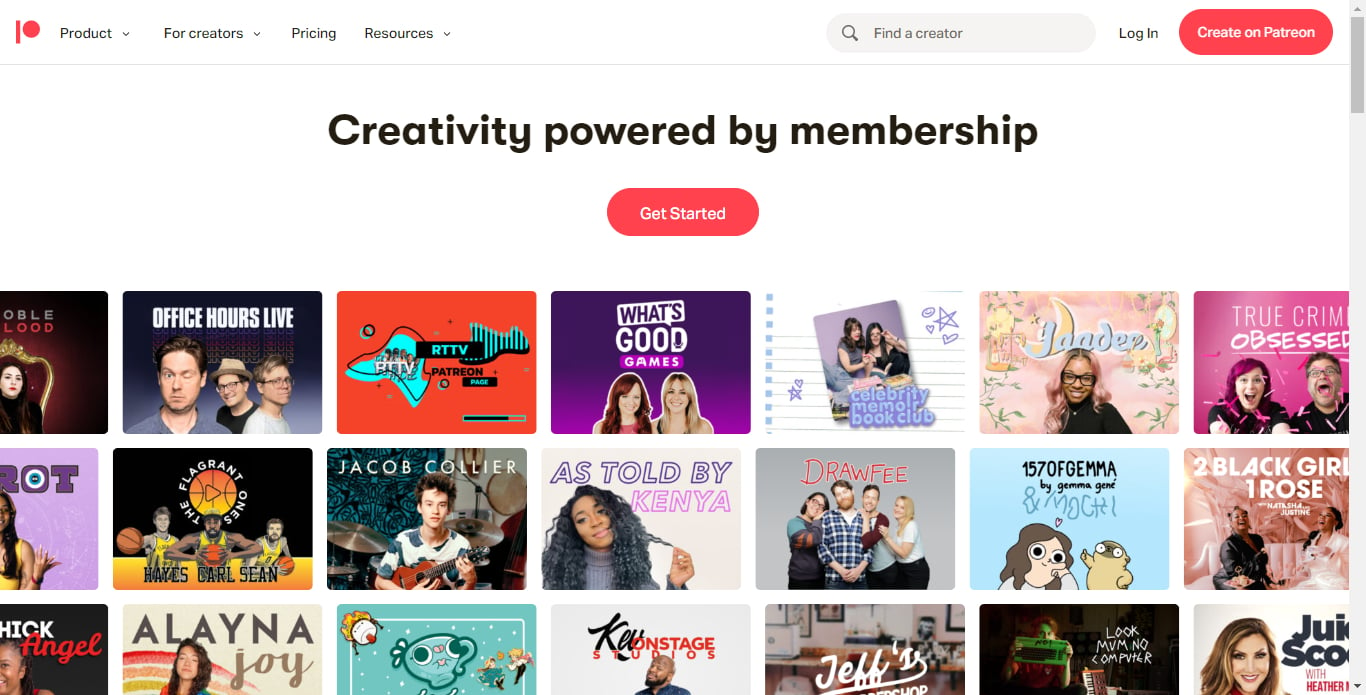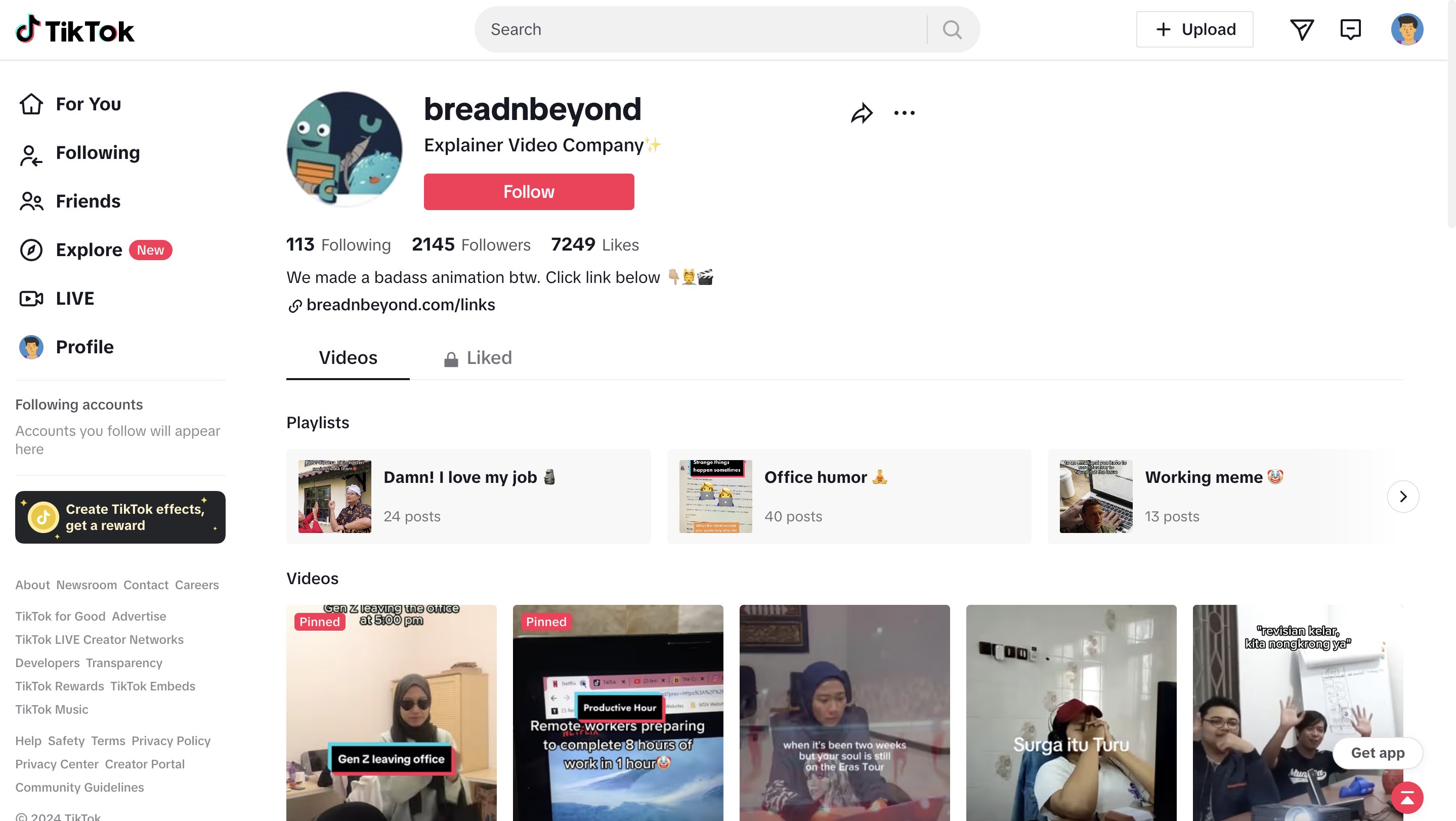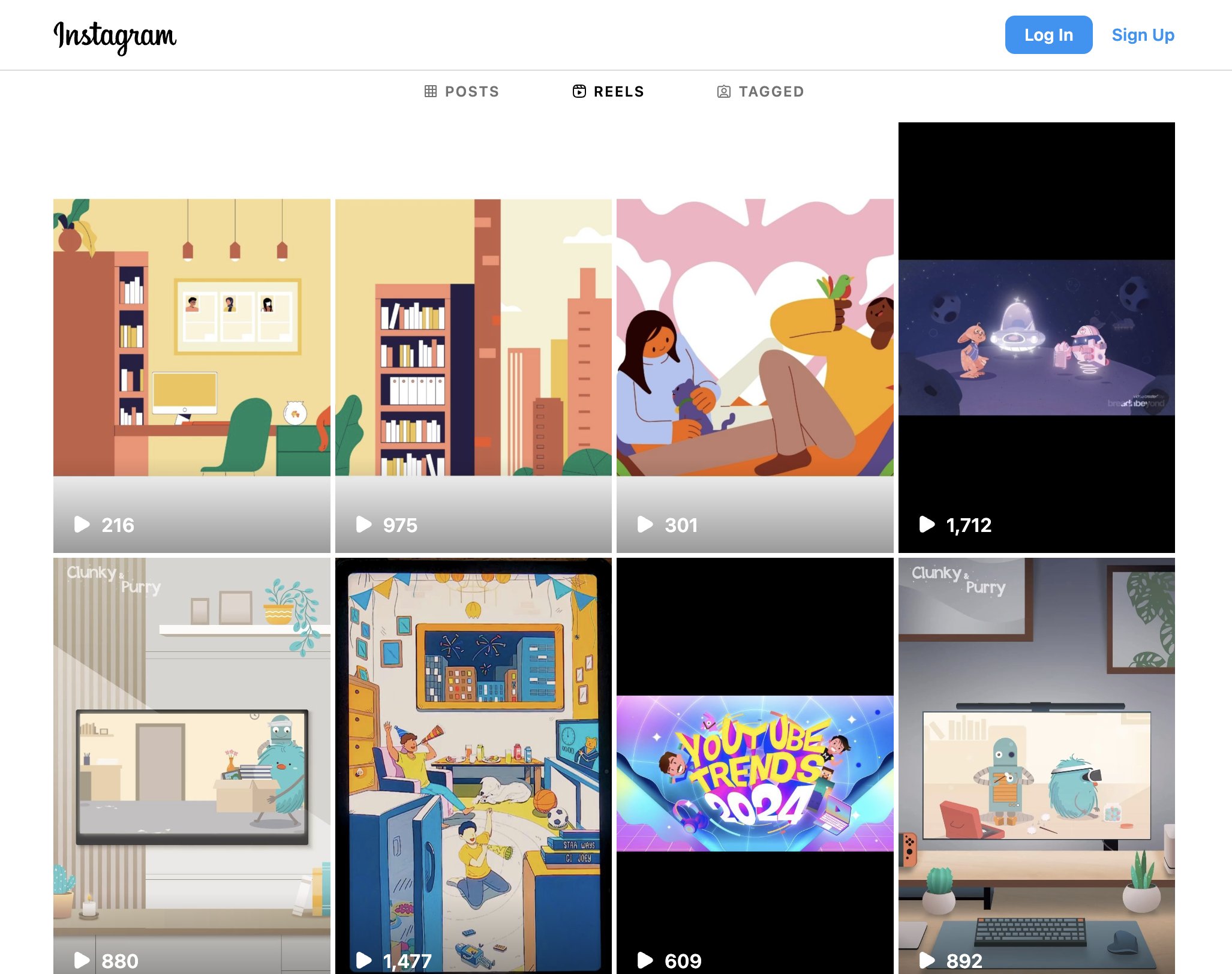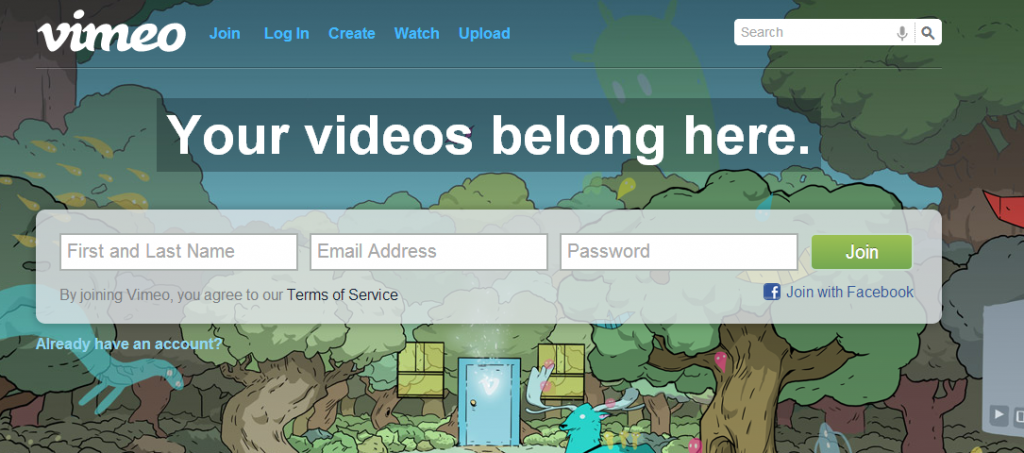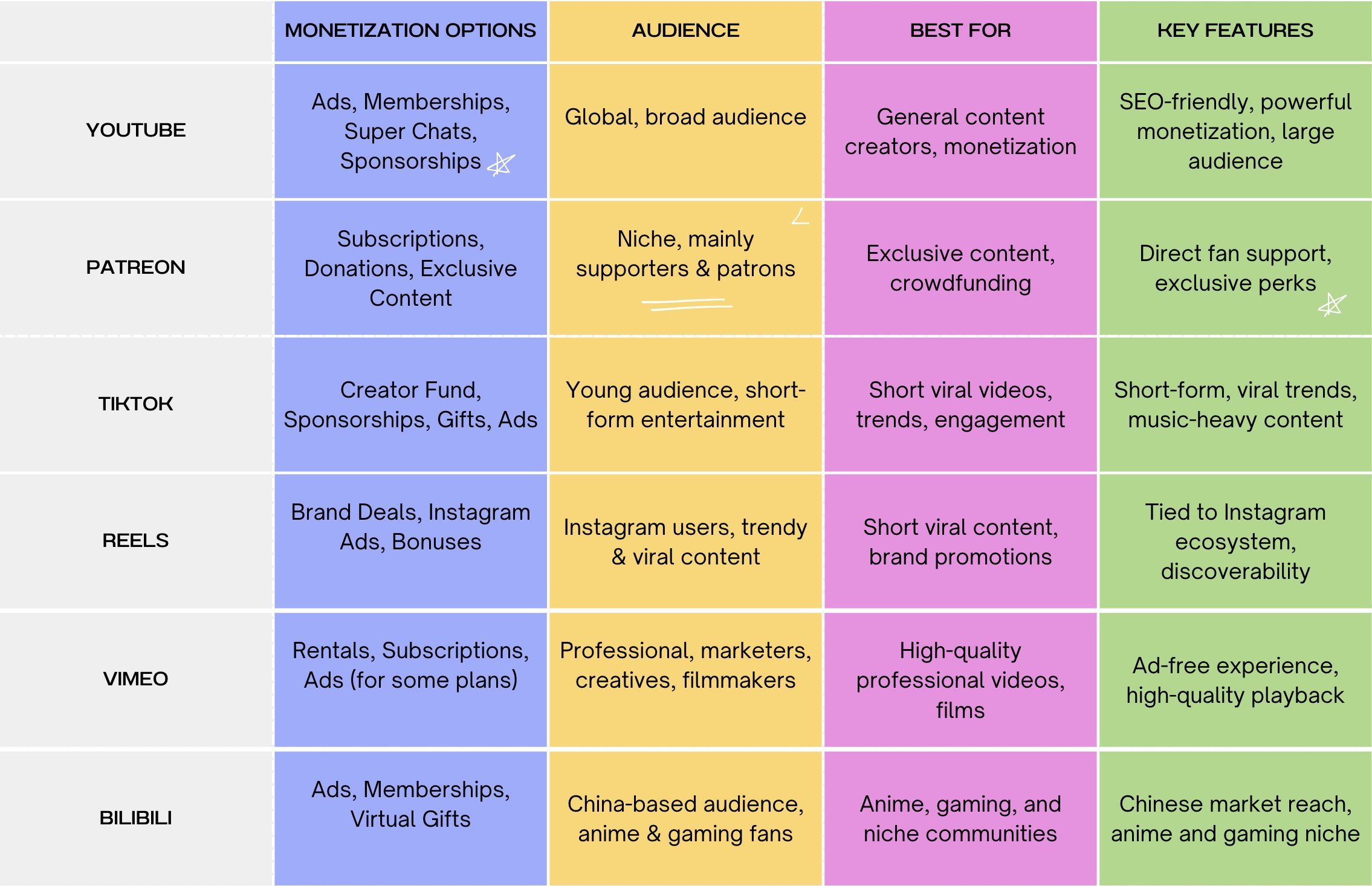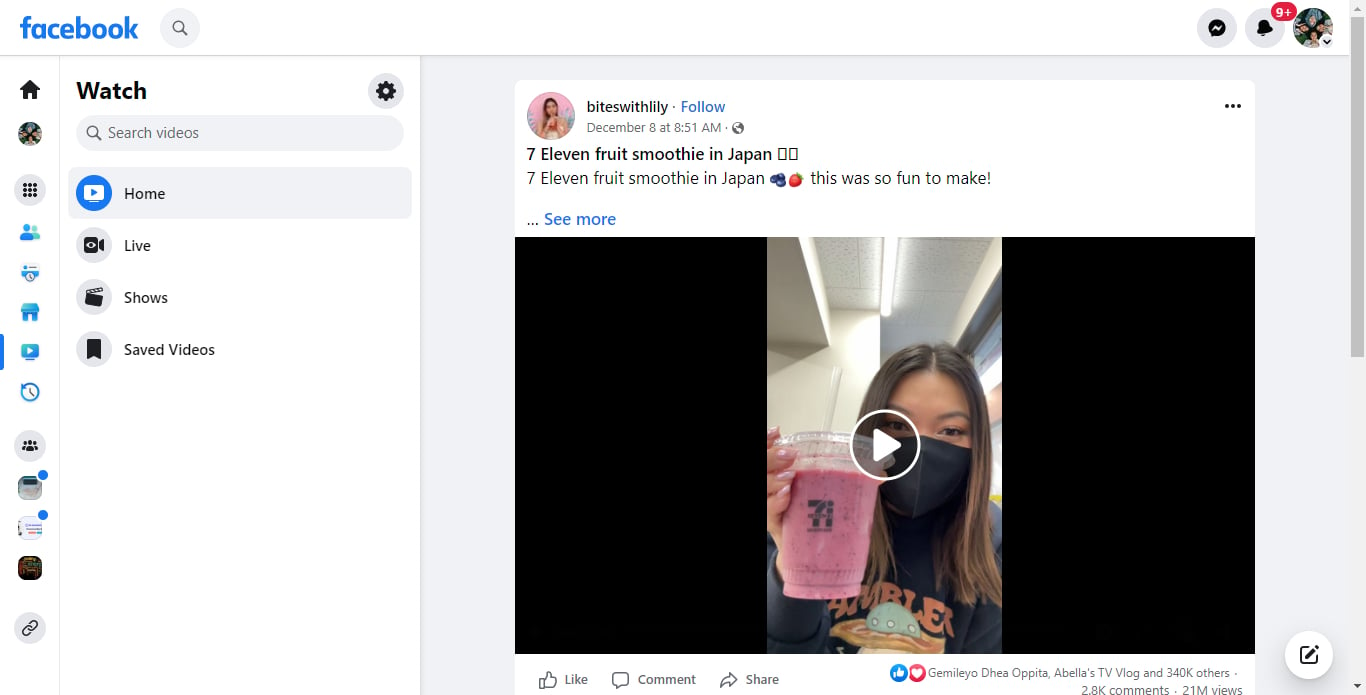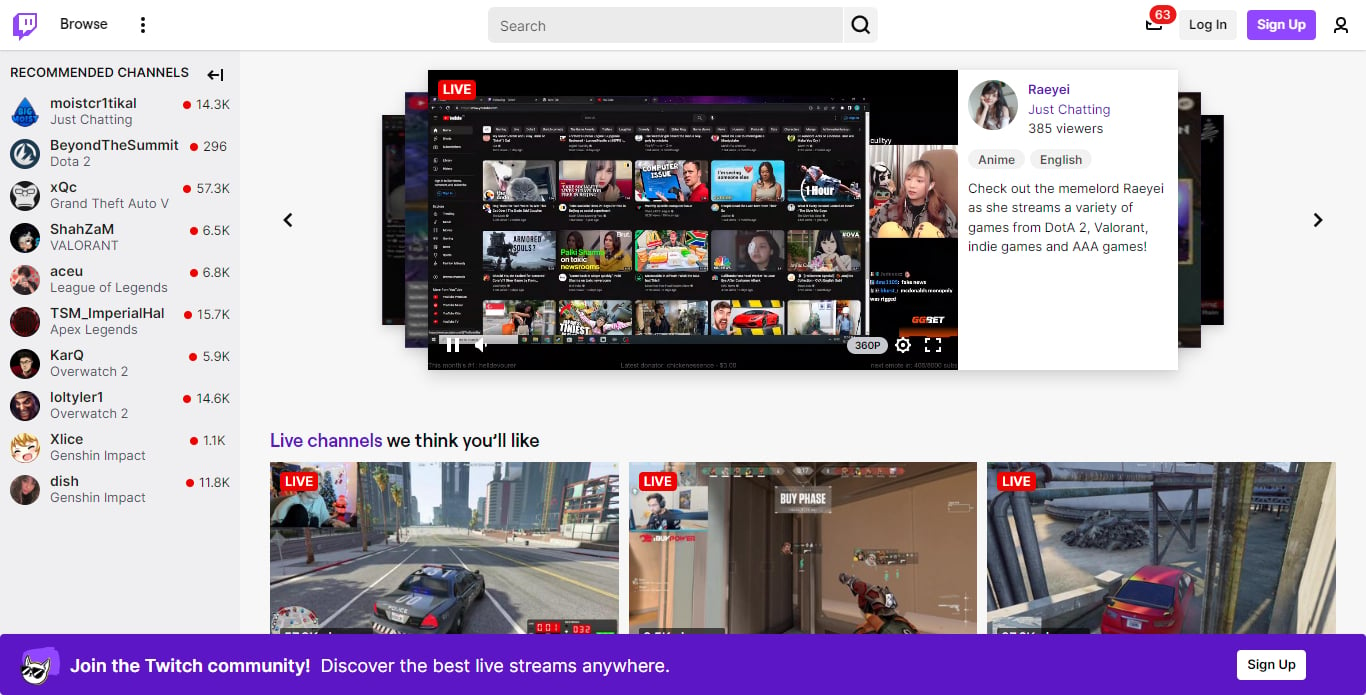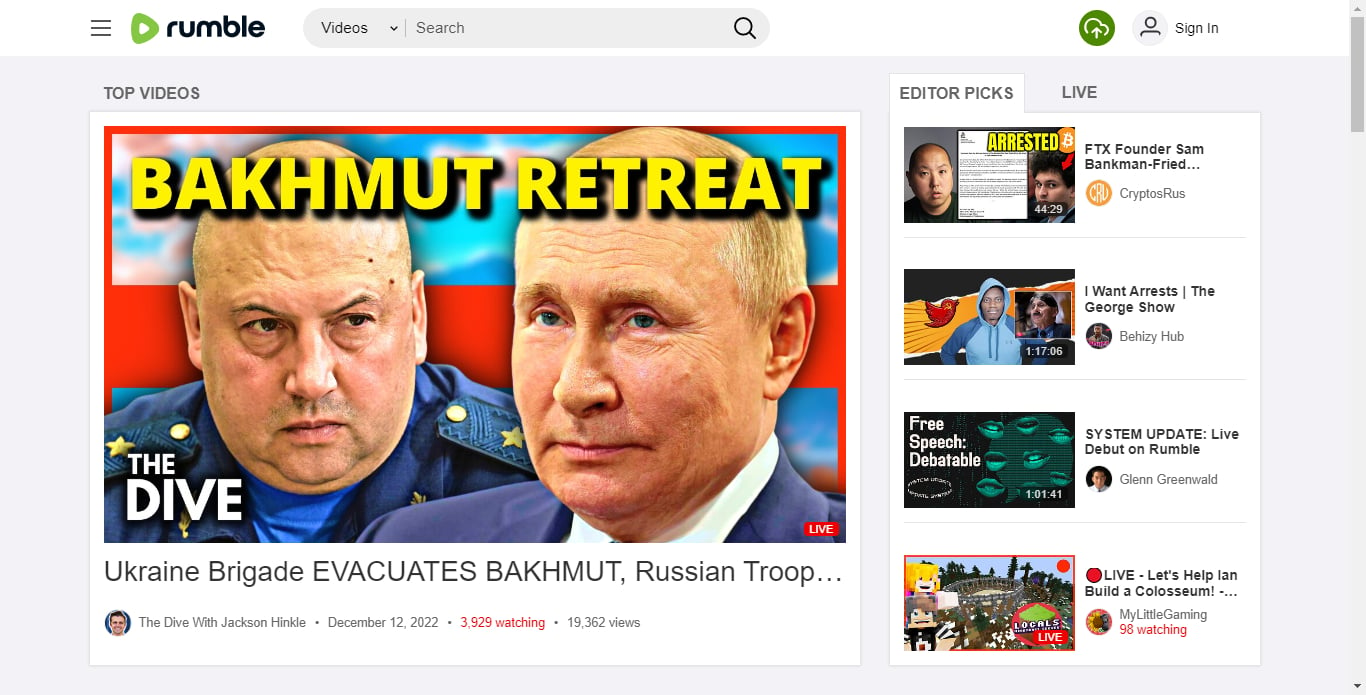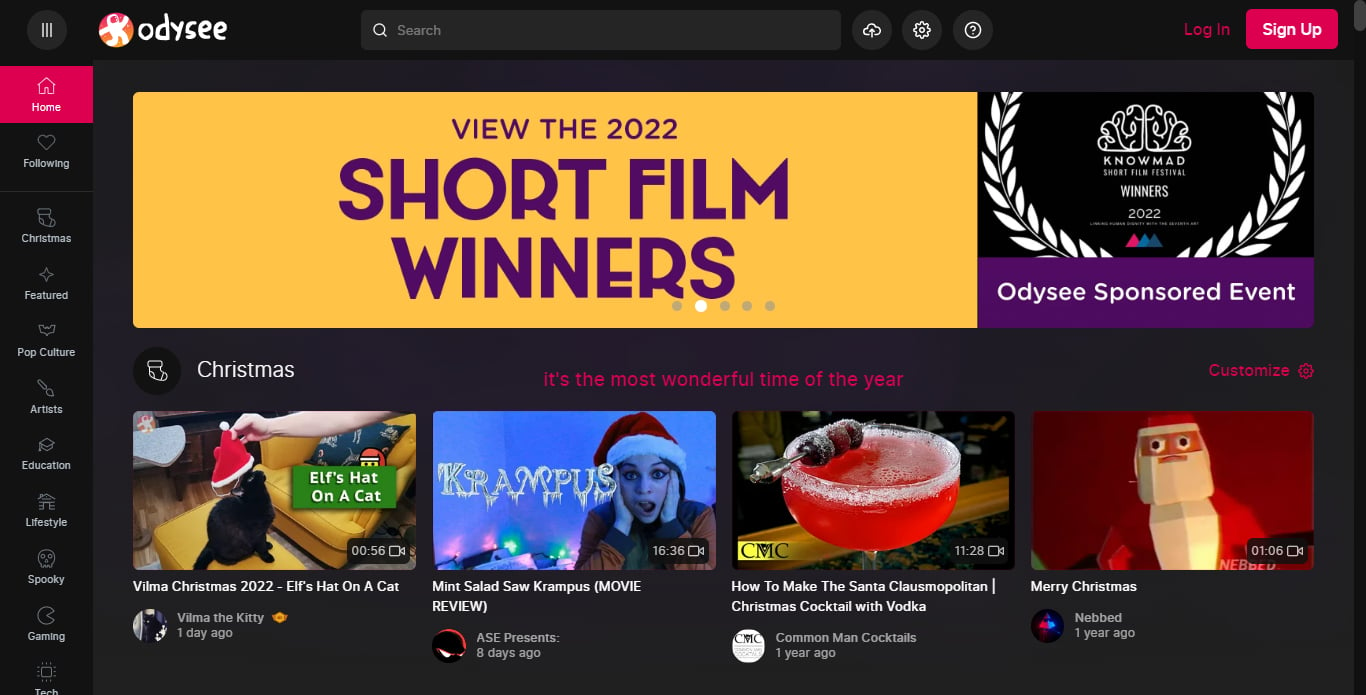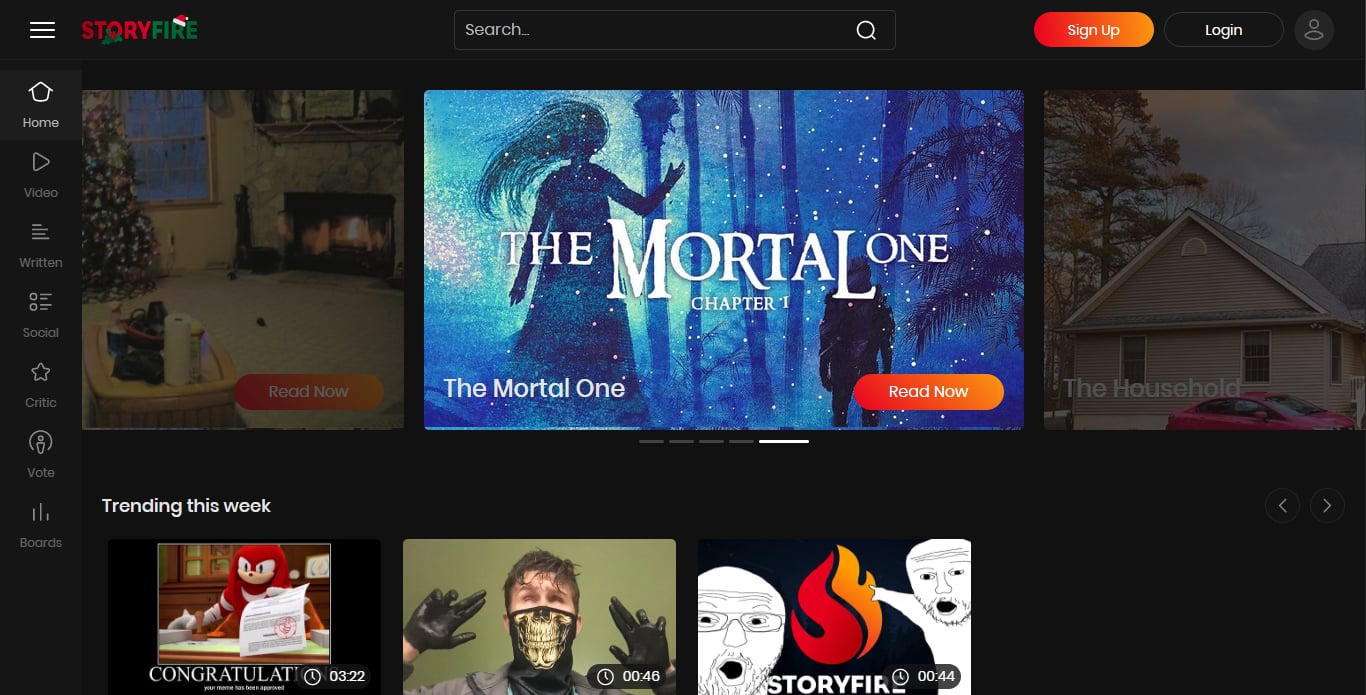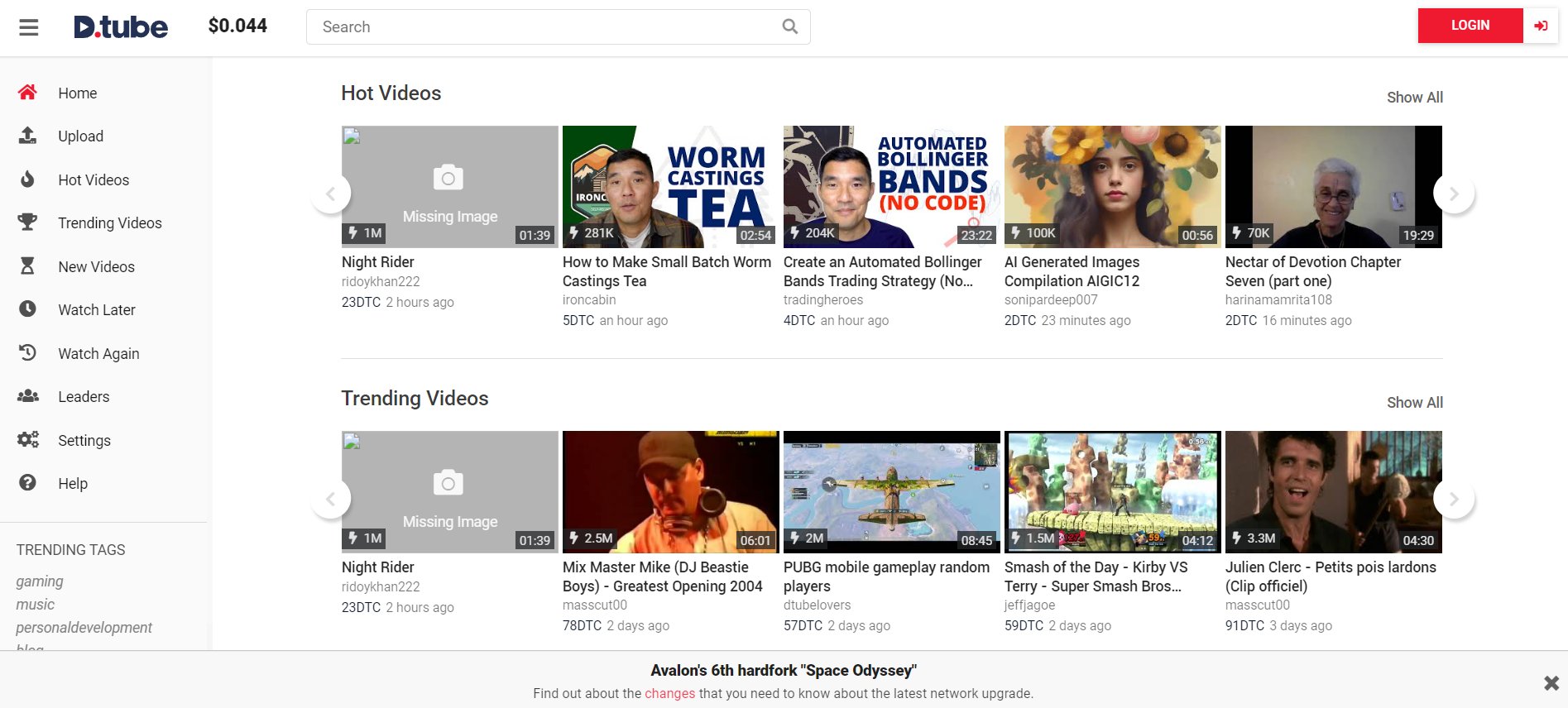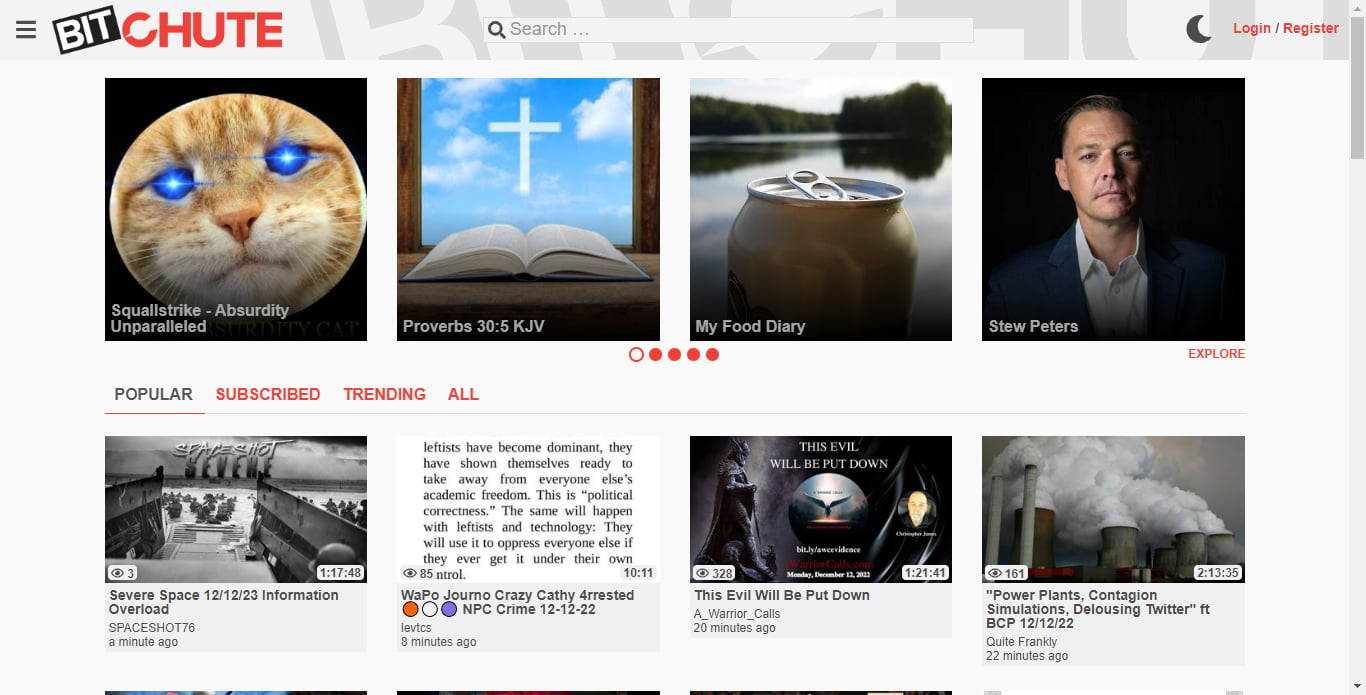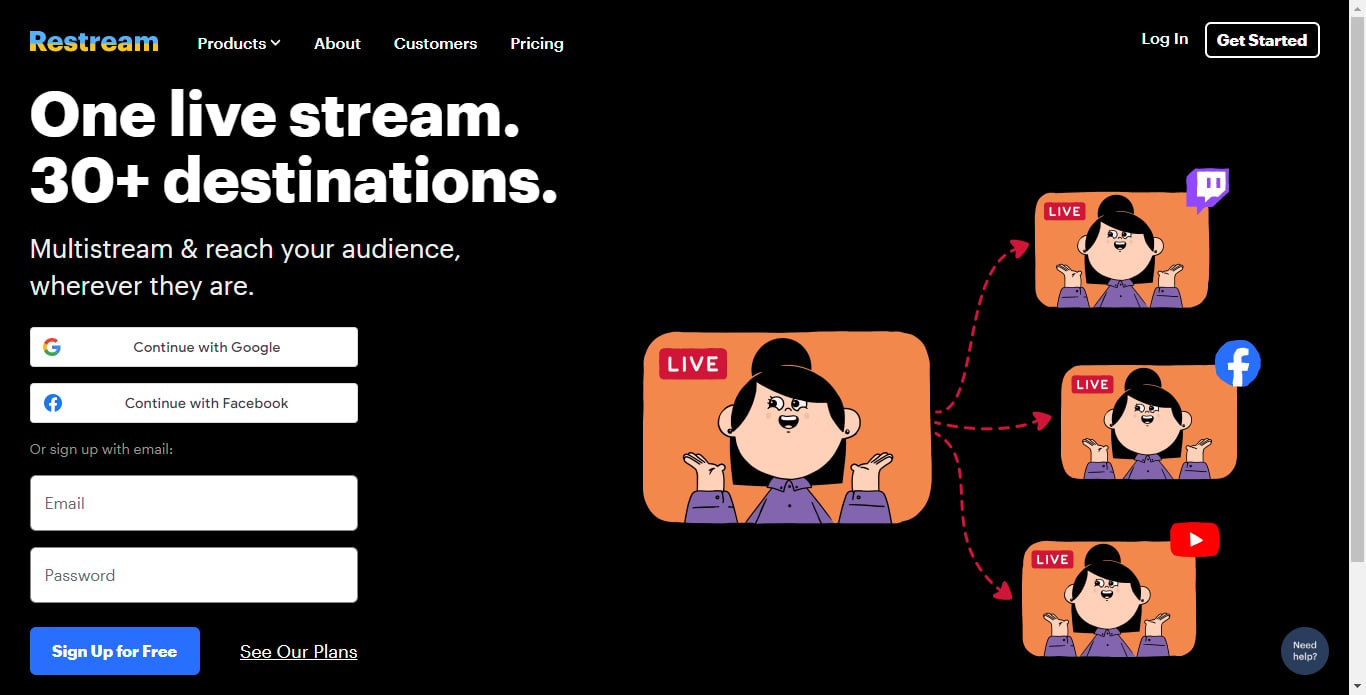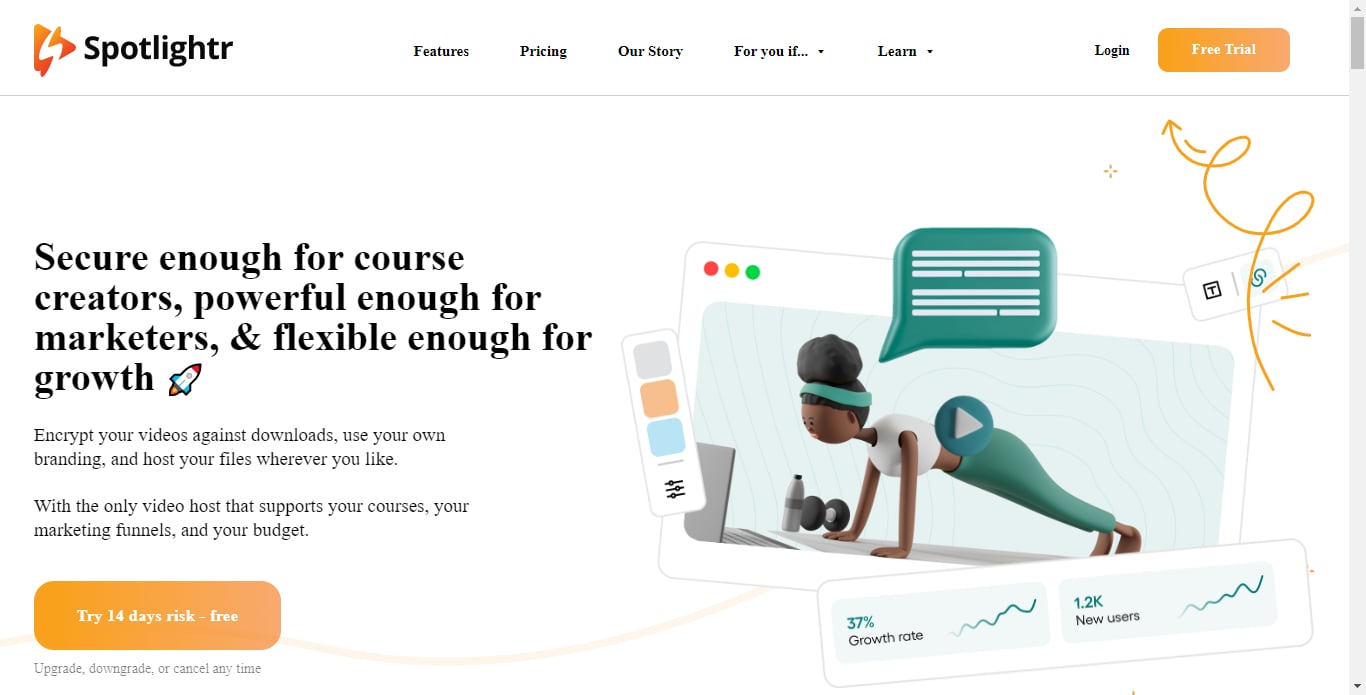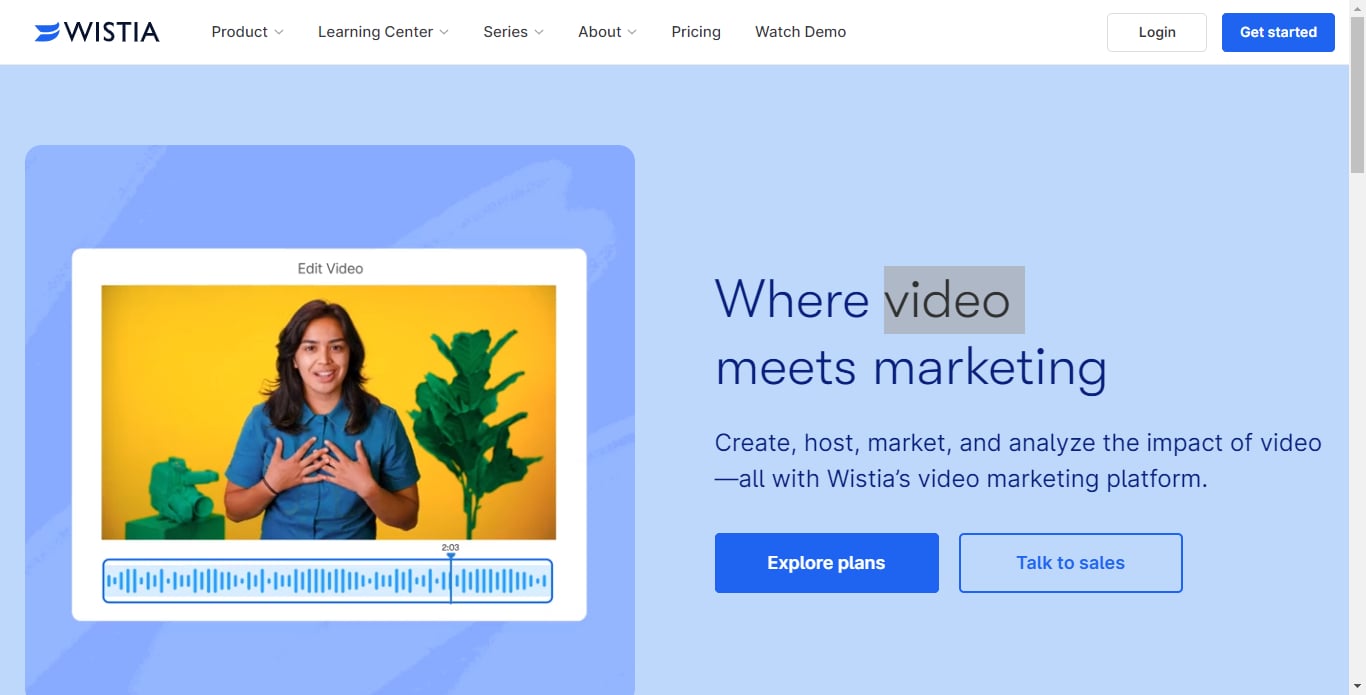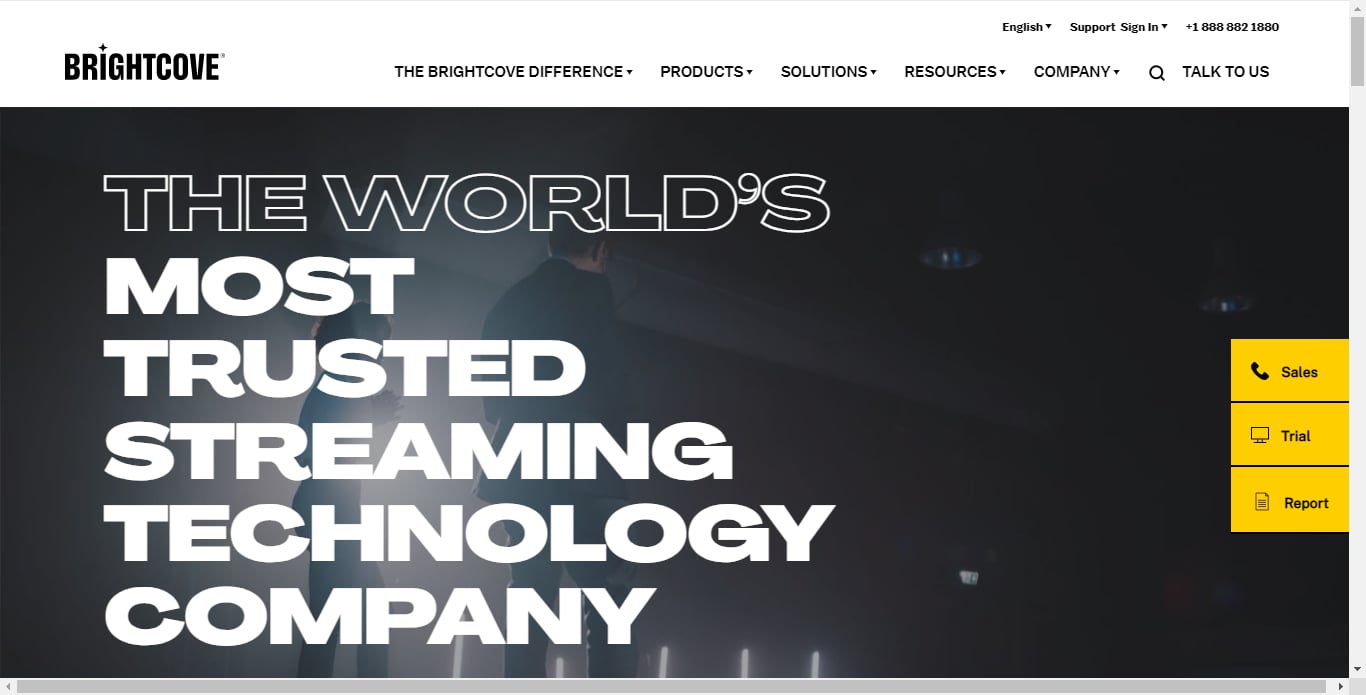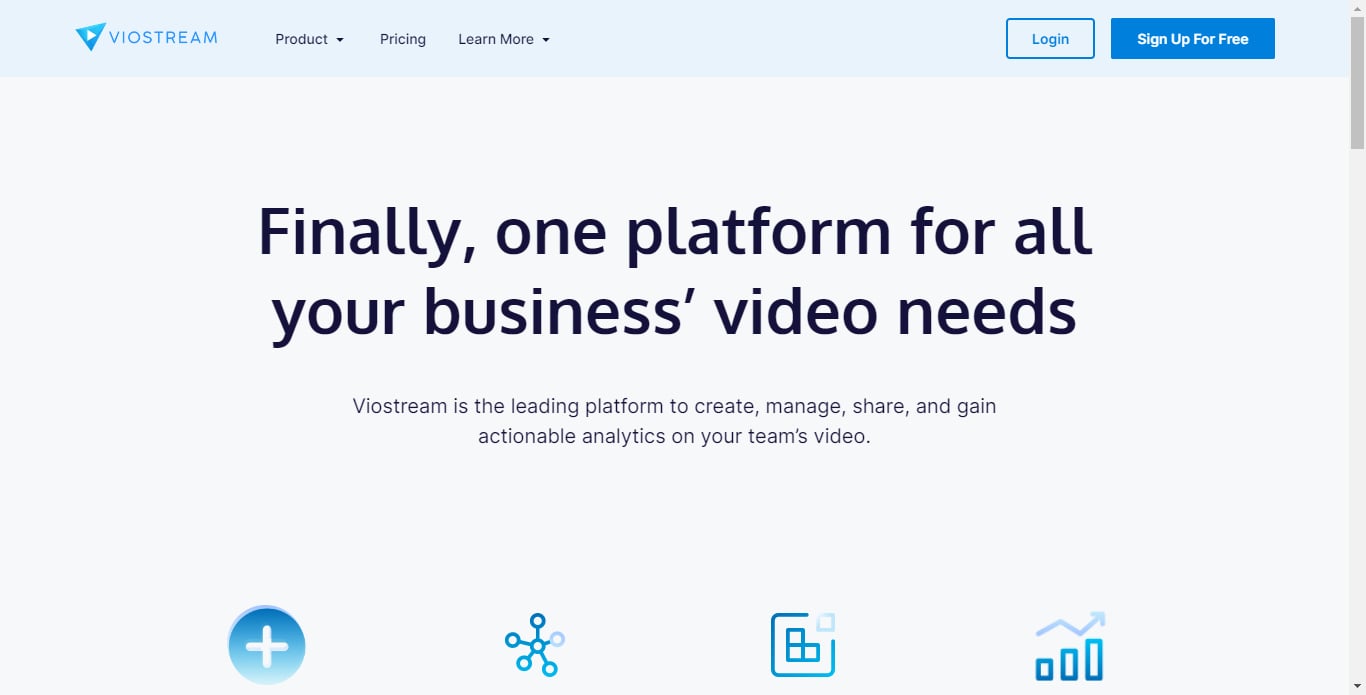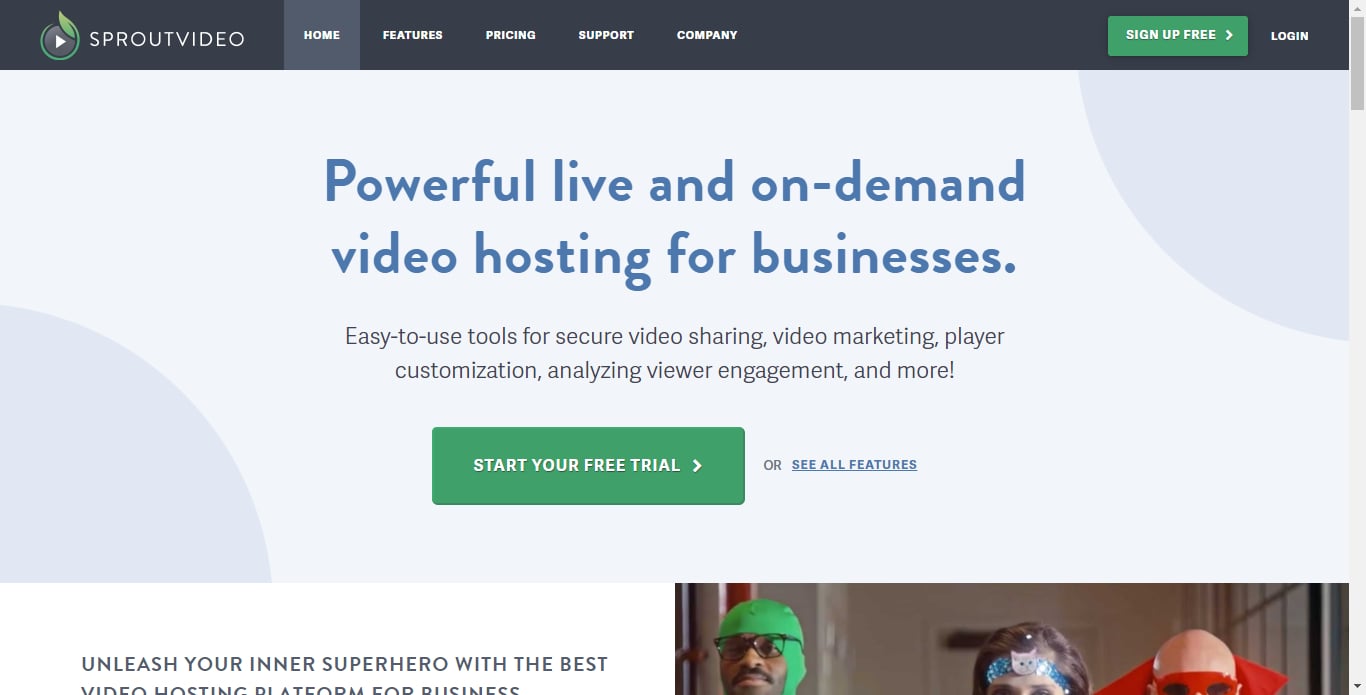Table of Contents ×
- 1 5 Best YouTube Alternatives for Creators & Viewers
- 2 20+ Other YouTube Alternatives Worth Exploring
- 2.1 1. Playeur
- 2.2 2. VideosHub
- 2.3 3. Dailymotion
- 2.4 Higher tolerance for content
- 2.5 4. Facebook Watch
- 2.6 5. Twitch
- 2.7 6. Crackle
- 2.8 7. Rumble
- 2.9 8. Internet Archive
- 2.10 9. Odysee
- 2.11 10. Storyfire
- 2.12 11. Peertube
- 2.13 12. 9Gag
- 2.14 13. D.tube
- 2.15 14. BitChute
- 2.16 15. Restream
- 2.17 16. Spotlightr
- 2.18 17. Wistia
- 2.19 18. Brightcove
- 2.20 19. Viostream
- 2.21 20. SproutVideo
- 2.22 21. Cincopa
- 3 Closing Thoughts
Just like most people, I automatically head to YouTube whenever I’m hunting down a video. But, there are several YouTube alternatives that I think should deserve way more attention than they’re getting.
Sure. YouTube is the second-largest search engine worldwide, and it’s where everybody goes for online videos. However, I’ve noticed something.
A lot of creators are grappling with YouTube’s strict copyright rules and even overall content rules, in general. Not to mention, now that the platform is super crowded, it is harder than ever to get YouTube subscribers.
I stumbled upon these YouTube alternatives that have some neat features that you might just find handy for your own videos down the line.
Since there are tons of options out there, I’ve narrowed it down to my top five picks for the best YouTube alternatives.
But that’s not all. There are also 20+ other platforms that I think deserve mention, too, since each caters to different types of content creators and audiences.
All being said, all of these alternatives offer features that you might want for future videos—plus, they’re free!
5 Best YouTube Alternatives for Creators & Viewers
Here are some of my top five YouTube alternatives that I think are worth your time, especially if you’re a content creator or just avid video fans who want to explore fresh platforms and discover new content without the hassle of strict copyright policies.
1. Patreon
If you want to focus on video monetization without worrying too much about copyrights and monetization rules, I personally think that Patreon is one of the best platforms.
What I like the most about Patreon is that it puts content creators in the driver’s seat when it comes to controlling what video content they choose to produce. No more feeling restricted or tied down by someone else’s rules.
It’s a highly flexible crowdfunding service that has fewer project restrictions than most video hosting platforms.
This is perfect for creative projects, not personal use. Also, the platform is heavily focused on supporting the arts or works through financial donations.
Patrons (that’s what the subscribers are called) need to subscribe to your channel and pay a monthly fee to access and follow your video content.
Who Uses Patreon?
Patreon isn’t a traditional video platform like YouTube, but it has become a game-changer for creators looking for direct support from their audience. Instead of relying on ads and algorithms, Patreon allows fans to pay for exclusive content through a monthly subscription model.
Patreon works best for:
- YouTube creators wanting financial stability beyond ad revenue
- Artists, musicians, podcasters, and educators
- Niche communities that value exclusive, ad-free content
Unlike YouTube, where viewers casually browse for free, Patreon’s audience is highly engaged and willing to pay for content they love.
What Kind of Content Works Best on Patreon?
Creators use Patreon for all kinds of content, but some formats thrive more than others:
- Behind-the-Scenes Content (bloopers, creative process, exclusive updates)
- Early Access Videos (letting fans see content before it drops on YouTube)
- Exclusive Live Streams (Q&A sessions, private coaching, or just hanging out)
- Bonus Footage & Deleted Scenes (extra content that doesn’t make it to YouTube)
- Educational & In-Depth Content (courses, tutorials, industry insights)
YouTube videos are built for mass appeal, while Patreon allows for deeper, more personal connections with a dedicated fanbase.
Monetization: How Patreon Stacks Up Against YouTube
YouTube relies on ads, memberships, and sponsorships, but income can be unpredictable, especially with demonetization issues. Patreon, on the other hand, gives creators steady, recurring income directly from their biggest fans.
Here’s how Patreon’s monetization model works:
- Monthly Subscriptions. Fans pledge a fixed amount every month.
- Tiered Memberships. Creators offer different perks at different price points.
- One-Time Contributions. Some creators allow one-off donations for exclusive content.
Since Patreon takes a small percentage of your earnings (5-12%, depending on the plan), creators keep more control over their revenue compared to YouTube’s 45% ad revenue cut.
2. TikTok
I used to think of TikTok as just a place for dance challenges and funny clips, but the more I explored, the more I realized it’s actually a solid alternative to YouTube, especially if you’re looking for fast engagement and algorithm-driven reach.
One of the biggest struggles with YouTube is discoverability.
If you’re a new creator, breaking through the algorithm can feel impossible. TikTok, on the other hand, pushes content based on interest, not just subscribers, which means even small creators can go viral overnight.
Another thing I love? The short-form format. While YouTube leans toward long videos, TikTok thrives on quick, engaging clips. This app is designed for mobile, so vertical videos are the default format.
This is perfect for people who just want to scroll and absorb content fast. Plus, with features like Stitch and Duet, it’s way easier to collaborate and interact with other creators.
Monetization-wise, TikTok has its Creator Fund, brand partnerships, live gifts, and ad revenue sharing, so there are plenty of ways to earn. And with the platform constantly expanding video length limits (up to 10 minutes now), it’s becoming even more of a competitor to YouTube.
For content creators, this app allows you to monetize your content through a program called TikTok Creator Fund.
Who’s Watching?
TikTok has an insanely engaged audience, and it’s not just Gen Z anymore. While younger users (ages 16-24) make up a big chunk, Millennials and even older generations have jumped on board.
The platform thrives on short-form, visually engaging content, making it perfect for creators who want to grab attention fast.
Unlike YouTube, where people actively search for videos, TikTok users mainly scroll through their algorithm-curated For You Page (FYP). This means content discovery is way more organic, and you don’t need a huge subscriber base to get noticed.
Types of Videos That Do Well on TikTok
TikTok is all about short, high-impact videos, but it’s evolved far beyond just lip-syncs and challenges. Some of the most popular content categories include:
- Educational & How-To Videos (quick tutorials, business tips, life hacks)
- Storytelling & Commentary (personal experiences, hot takes on current events)
- Behind-the-Scenes & Vlogs (daily life snippets, workplace insights)
- Product Reviews & Unboxings (especially in tech, beauty, and gaming)
- Entertainment & Humor (skits, trends, memes)
Compared to YouTube, where long-form and in-depth content thrives, TikTok forces creators to be concise, creative, and straight to the point.
The Algorithm: YouTube vs. TikTok
YouTube’s algorithm favors watch time, engagement, and consistency. This means if you’re new, it can take forever to build an audience. TikTok, on the other hand, is way more democratized.
- TikTok’s For You Page recommends videos based on user interests and interactions, not just subscriptions. This makes it easier for new creators to go viral, whereas YouTube prioritizes established channels.
- Trends move way faster on TikTok, and hopping on a viral sound or challenge can skyrocket views in a matter of hours.
- TikTok content has a shorter lifespan than YouTube videos, which can rank in search results for years.
Monetization: Can You Make Money on TikTok?
YouTube has multiple monetization options (AdSense, memberships, Super Chats, sponsorships), while TikTok is still catching up in terms of earnings.
That said, TikTok offers:
- Creator Fund (pays based on views, but income can be inconsistent)
- Brand Sponsorships (often more lucrative than ad revenue)
- Live Gifts & Donations (viewers can send virtual gifts during livestreams)
- TikTok Shop & Affiliate Links (great for selling products)
3. Reels
Instagram was once a photo-sharing app. Now, the app has embraced video format more than ever. IG Reels is the closest feature to YouTube Shorts.
It provides analytics and allows you to upload 90-second short videos.
Since Reels is made for vertical, it calls for tight shots and close-ups. Being too wordy or having videos filled with plain isn’t feasible for users.
Suppose you’re a business or content creator. In that case, this app is a perfect alternative to YouTube if you’re looking for a platform that allows you to engage with your audiences or constantly run influencer marketing.

Understanding the Audience
Reels are built right into Instagram, meaning they’re instantly available to Instagram’s 2 billion+ monthly active users. Unlike YouTube, where people actively search for videos, Instagram users discover Reels while casually scrolling.
The audience is diverse and global, ranging from Gen Z to Millennials and even older users, making it a great place for brands, influencers, and businesses to connect with different demographics.
What Kind of Videos Work Best on Reels?
Since Reels are designed for quick, high-impact content, they’re ideal for:
- Short How-To & Tutorial Clips (beauty, fitness, food, travel)
- Behind-the-scenes footage (personal branding, daily vlogs)
- Product Showcases & Reviews (great for e-commerce and tech)
- Trend-Driven & Viral Challenges (leveraging popular sounds and memes)
- Motivational & Inspirational Content (quotes, business insights, success stories)
With a 90-second limit, Reels force you to be concise and engaging right from the start. Unlike YouTube, where longer storytelling thrives, Reels are all about capturing attention fast.
The Algorithms: YouTube vs. Instagram Reels
One of Reels’s biggest strengths is its ability to push content beyond just your followers.
- The Instagram algorithm favors engagement. Videos that get rewatches, shares, and comments have a higher chance of going viral.
- Unlike YouTube, where searchability and SEO play a huge role, Reels gain traction through hashtags, trends, and Instagram’s discovery feed.
- However, the lifespan of a Reel is much shorter, while a YouTube video can be relevant for years, Reels tend to peak within a few days to a week.
Can You Make Money with Instagram Reels?
Instagram does offer monetization options, but it’s not as straightforward as YouTube’s ad revenue model. Some ways creators earn money on Reels include:
- Reels Bonus Program (invite-only, pays based on video performance)
- Sponsored Content & Brand Deals (a major income stream for influencers)
- Instagram Subscriptions (paywalled exclusive content)
- Selling Products via Instagram Shopping (especially useful for businesses)
Unlike YouTube, where ad revenue is the primary source of passive income, Instagram monetization is more brand and business-driven.
4. Vimeo
If you want to find a new source of traffic for your website, Vimeo can be a good place to upload your videos to the internet, and it has a lot of users and a good ranking position on search engines.
I use this platform myself to embed videos on my website. It’s hassle-free and accessible for users.
Also, as a person whose job is to create professional videos, I often get inspired by a tremendous number of high-quality short films and music videos submitted by the community.
Vimeo’s subscribe function is equivalent to YouTube’s, which is the opportunity for you to follow the channels (or users) you like. It also allows other users to leave comments.
The features below are what make this platform stand out to me:
Superior video quality
I know that YouTube is notorious for heavily compressing video and, therefore, losing quality in favor of less data on their server. Vimeo presents my video as-is without any compression.
In other words, my video will look as good as it did coming out of the rendering software.
However, with the advancement in camera technology, the file sizes are getting ridiculously bigger — there’s a real chance Vimeo will start applying compression to their videos.
Branded video player
Vimeo has a feature that allows users to customize how the frame of the video player looks.
So, as a user, I can match the player to my homepage, business portfolio, brand identity, or marketing campaign by tweaking its appearance. This is my new play area for creativity in coloring and design.
To change the text colors and upload the logo to a specific video, go to video settings and click the Embed tab.
Customized privacy control
There’s a vast range of privacy and playback control options on Vimeo.
One of the handiest features for me is the ability to limit playback anywhere except on your own website or other websites of my choosing.
This means users can make the videos exclusively available on their website, which is likely to get us more visitors and a higher conversion rate.
Customizable video URLs
Vimeo also gives me the liberty of changing the URL of my videos– and I find it easier to customize them according to my preferences or needs.
I don’t have to worry about complicated or fixed URLs that don’t suit my branding or organization. This customized URL also gives my content a professional look, boosting its credibility and appeal to viewers.
Outstanding customer service
The clearest win that Vimeo has over YouTube is how easy it is to contact them.
The forum activity and customer service are simply ahead of YouTube. Granted, YouTube is well ahead by millions in terms of the number of people submitting queries.
peech and censorship-resistant, then you might check out BitChute, which is a great option. The site is free to use.
5. Bilibili
Bilibili is a Chinese video-sharing platform that is popular among young people in China. People also call it China YouTube.
It’s an online home for fans of anime, manga, and other forms of geek culture. This makes it a great platform for content creators who are into that sort of thing.
Of course, anime, manga, and cartoons aren’t the only type of content on the site. You can find all sorts of videos, including music videos, movies, TV shows, and more.
The live-streaming feature helps you to potentially reach a larger audience with your content.
Also, Bilibili is a great option to host your videos if you’re targeting the Chinese market and audiences.
A Deep Dive into Bilibili’s Audience
Bilibili is huge in China, with over 300 million monthly active users, primarily Gen Z and Millennials. It started as a platform for anime, gaming, and tech content but has evolved into a full-fledged video-sharing site with a highly engaged community.
Unlike YouTube, where viewers might passively consume content, Bilibili’s audience is more interactive, often leaving “bullet comments” (real-time overlay comments) that create a shared viewing experience.
Can You Make Money on Bilibili?
Yes, but the system is different from YouTube’s ad-based model. Some ways creators make money on Bilibili include:
- Bilibili Partner Program (ads, revenue-sharing, and paid content)
- Live Streaming Gifts (similar to Twitch donations)
- Fan Memberships (viewers pay for exclusive content)
- Brand Collaborations (especially for influencers in tech, gaming, and anime)
If you’re used to YouTube’s AdSense payouts, Bilibili’s monetization might feel less predictable, but it offers more ways to earn through direct audience support.
If you’re targeting a Chinese-speaking audience or your content fits anime, gaming, or tech niches, Bilibili is a fantastic platform with less competition than YouTube.
However, since Bilibili is mainly for the Chinese market, creators who don’t speak or localize content for Mandarin speakers might struggle.
Here’s a handy table I put together comparing YouTube with Patreon, TikTok, Reels, Vimeo, and BiliBili. If you’re looking for a new platform, I hope this breakdown will help.
20+ Other YouTube Alternatives Worth Exploring
Five YouTube alternatives weren’t enough, so I went ahead and rounded up 20+ more YouTube alternatives that might just be what you’re looking for. Want a less crowded space? A platform tailored to your niche? There’s something here for everyone.
1. Playeur
I don’t think this platform sounds familiar to most of us, and I think it’s because it’s considerably new. However, Playeur, formerly known as Utreon, is a video hosting platform that aims to become a real alternative to legacy video platforms such as YouTube.
It launched in late 2020 with unique features, reasonable rules, and a sleek and easy-to-use UI that have all been key to its growth.
Creators on Playeur can monetize their content through subscription revenue and will have access to several other monetization features in the near future.
Playeur has many exciting features in the pipeline, such as an iOS app, live streaming, and community feeds.
I’ve dug some perks of using this platform:
It’s easy to get started
Joining Playeur is a frictionless process. They take care of all the heavy lifting by importing content from your existing YouTube channel and syncing your future uploads.
Earn Money
Subscriptions are the first of what will soon be many monetization features on Playeur. You can always monetize your channel simply.
Also, all your most dedicated fans will be able to subscribe to your channel at one of three different tier levels.
Reasonable approach
Tech giants are deciding what can be expressed on social media and have shown themselves incapable of being unbiased/honest with their users or creators.
Other platforms have reacted to this by declaring themselves the wild-west of the internet.
Playeur takes a more reasonable stance. Simply put, Playeur has clear rules, and the rationale behind these rules is explained. Moreover, they apply fairly and evenly.
Engagement and Communities
Viewers want to interact with their favorite creators and participate in real communities.
They want to post memes, ask questions, share their favorite clips, earn approval, and more.
Playeur provides an interactive comment section for videos and focuses on implementing features that allow creators and users to interact in more ways than ever.
2. VideosHub
VideosHub is another great alternative to YouTube that I think should deserve more attention. VideosHub has a great system to ensure all uploaded videos are of high quality and there are no duplicates on their website.
They also classify videos into different categories, including entertainment, sports, video games, movies, news, and TV, and receive millions of unique viewers each month.
I realize that there are many people who aren’t really familiar with VideosHub. So I tried to round up these quick facts about the platform:
- VideosHub is one of the largest video-sharing sites, with 2 million visitors a month on average.
- There is a reward system called the Producer Reward Program that allows you to get revenue from your videos.
- You can get paid up to $5 per 1,000 visits from this program.
- Sadly, your video needs to rack up 20,000 views to be eligible for this program.
3. Dailymotion

Dailymotion is also a popular video-sharing service that can offer a great user experience even compared to YouTube.
It also has a clean and simple video player. Overall, it shows how much work the pro developers have put into the Dailymotion UI.
Here’s what I find fascinating about this platform:
Better video quality with less quantity
Apparently, YouTube is really good at making a heavy loss in video quality. Dailymotion provides viewers with a version of each video that is closer to the source.
However, Dailymotion is far from competing with the thousands of videos that are uploaded to YouTube per day.
Better flexibility
YouTube, with its copyright strikes, is quite scary as of late. Uploading your videos to Dailymotion is less risky since the producers are more tolerant, and the copyright policies are yet to be as strict as YouTube’s.
All in all, if you’re not sure you have the rights to every element in your video, Dailymotion has a smaller risk of copyright claims.
Higher tolerance for content
While both YouTube and Dailymotion have their own rules on what can and can’t be uploaded, Dailymotion has somewhat of a better tolerance for it by providing options for uploaders to set an age gate.
4. Facebook Watch
You may not think of Facebook as a video-sharing website or as an alternative to YouTube.
However, Facebook has a video feature called Facebook Watch, where users can upload and share videos.
Uploading videos to Facebook Watch is very simple.
There are also support tools that you can use to optimize your video, including thumbnails, tags, and the option to add a meta description.
On top of that, you can upload HD videos without any downscaling.
You can also make live videos on Facebook more easily than on YouTube or other desktop platforms.
Before you start creating videos for Facebook, you can read and learn more from our social media video tips to get better results.
An open comparison between Facebook and YouTube isn’t really fair, as one is primarily a social media platform, whereas the other is only for sharing video content.
However, we can compare the two on their capabilities as video. It’s also worth noting that video posts on Facebook are weighted more than regular text posts by its latest algorithm.
5. Twitch
YouTube is a good platform for uploading lasting, pre-recorded, well-polished content.
Twitch is one of the best options if you’re looking for an alternative specifically designed for live-streaming videos.
Twitch is the largest platform for live streaming, with most of the content built around video games and a thriving community atmosphere.
We can say that this is the go-to online place for live streamers.
It allows streamers to get donations and subs while they do a live stream. That is what makes some users choose to be full-time Twitch streamers.
However, if you want to start to build your presence on this platform, it can take time to break through.
Twitch tends to promote those channels that already have massive followings. That means the bigger your audience is, the more Twitch will push your channel.
6. Crackle

Whenever I try to watch a free movie on YouTube, I often find myself navigating through countless trailers and clips, only to discover that the full movie isn’t available for free.
The platform is quite harsh with its copyright issues. Although there’s YouTube Primetime that offers you originals or free movies, the choice is fairly limited.
For more options, you can rent or buy movies on YouTube Movies.
Crackle is a place where users can watch uncut and unedited Hollywood movies. However, it’s only available in the United States.
If you want to upload your indie films or small movie projects, Crackle may be worth a try. I love how they provide a platform for filmmakers to showcase their work, even if it’s not mainstream– to foster a diverse range of content for viewers to explore.
This is the place for movie buffs that feel adventurous and look for an alternative that allows them to stream movies for free.
There are tons of direct-to-video or little-known indie films. You might find a handful of old or almost-forgotten favorites and hidden gems that users can watch for free.
7. Rumble
Rumble is an online video platform launched in 2013, started out with a self-declared free-speech platform.
It contains viral videos that are commonly seen on YouTube and other social media, but it has looser restrictions on what constitutes a violation of its video policy
It is basically comparable to YouTube, with fewer restrictions and a simpler algorithm.
This is the place where content creators have an unfiltered connection with users. Unlike YouTube, shadow banning is not even a concern.
If you follow politics or are trying to shift away from traditional social media, this platform might be a good fit for your videos.
You can monetize your channel too. You can earn revenue from ads that are shown on your videos.

8. Internet Archive
The Internet Archive is a non-profit library where you can access millions of movies, books, and even software.
This is a treasure of historical content and obscure news reports, TV series, and movies that are typically hard to find anywhere else.
If you have documentaries and you want to make your videos accessible for public knowledge, you might want to upload them here.
The site isn’t the most user-friendly, but it’s a good place to archive vast amounts of very important data and make it freely available for everyone.
9. Odysee
Odysee was created to recapture some of the freedom and independence of the early internet, where anyone could have a voice.
The site was created by the team behind the LBRY blockchain protocol.
That means if you create a channel on this platform, it exists in a cryptocurrency wallet that you can download. The content remains on the blockchain permanently.
That all said, if you want to put whatever video content you want online and keep it there without the risk of it being removed, this platform might be a good option.
It can give you more control over your own content and audience– and you won’t get banned for the smallest thing.
Streamers on Odysee get 93-95% of their tips. And content creators get 100% of their membership.
Plus, there are no far-too-strict guidelines for users. There are basic community guidelines that prohibit things like pornography and content that promotes violence or terrorism.
10. Storyfire
Storyfire is a creative video or writing social entertainment platform. The platform combines YouTube–Twitter–and Wattpad.
StoryFire claimed to be an edgier alternative to YouTube with revolutionary monetization features and support for the creative.
The platform is well-known for its passionate community of writers and video creators earning a full-time living from content creation.
It is worth checking out if you love storytelling through video or if you have a story-driven video series and want to grow a fanbase.
Users can use its in-app currency known as “Blaze” to pay creators for posting original videos, stories, and even tweets.
11. Peertube

If you want to have complete control of the place where you place your videos, PerTube has the solution.
PeerTube allows you to create your own video platform with complete independence.
It means that you make your own guidelines and don’t have to deal with opaque algorithms or obscure moderation policies.
It is free, open-source (no need to pay to install it on your server), and created for non-commercial purposes.
12. 9Gag
9Gag isn’t something new if you’ve been on the internet for quite some time.
It’s the place where people look for a chuckle, so if you’re creating memes, GIFs, and comedy videos, this could be a great YouTube alternative for you.
The very specific niche 9Gag community makes it easy to go viral.
You can only upload videos that are funny, entertaining, or weird– though. Otherwise, your videos will be taken down.
13. D.tube
I just found out about this platform when blockchain and cryptocurrency became the talk of the town couple years ago.
D.tube is a blockchain-based video-sharing platform that is quickly gaining popularity. It’s similar to YouTube in terms of functionality, but it has some key differences.
For one, it’s decentralized, meaning there is no central authority controlling what gets uploaded and what doesn’t. This could make it a great platform for controversial content that might get censored on YouTube.
Just like YouTube, D.tube also pays creators for their content.
This is made possible through a token system, which means that you could potentially make a lot of money if your content gets popular. Creators will get rewarded with cryptocurrency.
One catch, though, is that since your videos will be stored in a blockchain, they’ll be permanent. So, if you delete your DTube account, your videos will still be there.
14. BitChute
BitChute is another decentralized video-sharing platform that is similar to DTube. It also has a token system that allows creators to earn money for their content.
However, BitChute has a different focus than DTube. It’s designed to be a safe haven for free speech, which means that it’s a great platform for controversial content.
It’s well-known for being a place full of conspiracy theorists and content
If you’re looking for a YouTube alternative that is focused on a free subscription, you can choose it.

15. Restream
Restream is a live-streaming platform that allows you to live-stream your content to multiple platforms at once.
This is ideal if you’re trying to reach a large audience with your content. You can live-stream on YouTube, Facebook, Twitch, and more.
Restream has a free plan that lets you livestream to three different platforms. If you need to livestream to more platforms, you’ll need to upgrade to a paid plan.
As a content creator, you can also make money through Restream.
16. Spotlightr
The most common problem I experience when embedding YouTube videos on other sites is the broken thumbnails.
If you’re like me, Spotlightr offers a solution. This platform will encrypt your videos against downloads and host your files wherever you like.
It means you can have your own branded player and watch page with your embedded logo and color palette.
This is worth checking out YouTube alternatives, especially for marketers.
Spotlightr can also show you the progress analytics and offer marketing tools like email gating, email integration, and pay-per-view.
17. Wistia
Wistia is another video hosting platform designed for business and marketing professionals.
While YouTube is great for monetization and the general public who want exposure, Wistia is designed exclusively to support the needs of B2B companies using video for marketing, support, and sales.
Wistia gives you a full control experience of your videos and video player.
Since the main purpose is to help businesses reach out to other businesses, it allows you to embed videos ad-free, create customized thumbnails, include CTA, optimize the video, and see more in-depth analytics. All in one platform.
You can even drill down to see how individual viewers are watching your videos with our heatmaps.
18. Brightcove
If you need a YouTube alternative that has more content management features, Brightcove is worth mentioning.
It’s a cloud-based video tool with enhanced media management features designed for businesses that require more scope than what YouTube currently offers.
Brightcove offers improved analytics, security, and integrations built for B2B.
The OTT technology allows you to deliver live videos on smartphones and smart TV apps.
This video-hosting platform also makes it much easier for you to streamline the overall content management, live streaming, encoding, batch editing, and create playlists with a drag-and-drop feature.
19. Viostream
Viostream is well-known for its broad range of integrations, privacy, and security features.
It’s an enterprise-grade video platform for organizations and businesses that aim to take video management to the next level.
Viostream integrates with services like Adobe, Looker, Oracle, Tableau, Salesforce Einstein Analytics, and more.
It can be a great YouTube alternative if you’re looking for a video-hosting platform that can help you not only understand the analytics but also generate deeper data insights that reveal video ROI.
Not to mention that Viostream also provides all the basics you need in a video-hosting platform, such as video embedding, live streaming, audience management, unlimited users, unlimited players, calls-to-action, etc.
20. SproutVideo
If you’re a small business or solopreneur who has serious digital marketing chops, SproutVideo is one of the most robust YouTube alternatives you should check out.
It allows you to create your own video player. No more YouTube logos that can make your brand less professional.
SproutVideo also ensures that your embedded video won’t clash with your design but complement it.
It integrates with MailChimp, Hubspot, Zapier, and many more third-party tools.
21. Cincopa
Cincopa is an all-in-one video hosting platform that allows individuals and teams to upload, manage, host, and enhance videos with tons of tools, such as CTAs, lead generation forms, advanced analytics, and galleries, to help video content generate more engagement.
Cincopa’s platform allows users to host live streams and webinars, invites users both internally and externally to upload to their account, and integrates over 100 apps, including popular CRM software like HubSpot and Salesforce!
Closing Thoughts
I hope this list gives you other options when you want to look at more videos beyond YouTube. Every website has its own features and benefits. So choose one that fits your needs most.
I keep updating this list because new video platforms are always popping up, and some hidden gems deserve more attention. While YouTube is still the go-to for most people (myself included), it’s not the only game in town.
Once you’ve chosen which one you’d like to use, the next step is to create an enticing thumbnail to help amplify your engagement rate.
No matter what platform you use, explainer videos have a high potential to catch more eyeballs. Create yours today with us! Click on the banner below to see the package that we offer:


